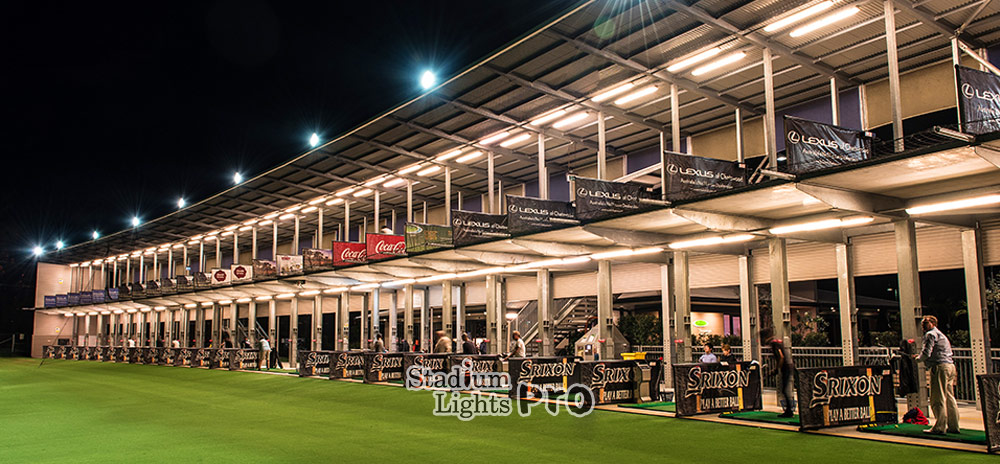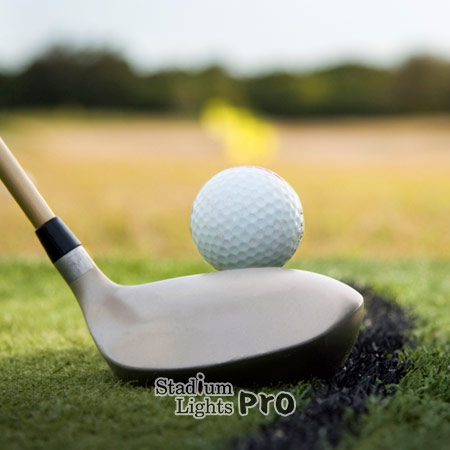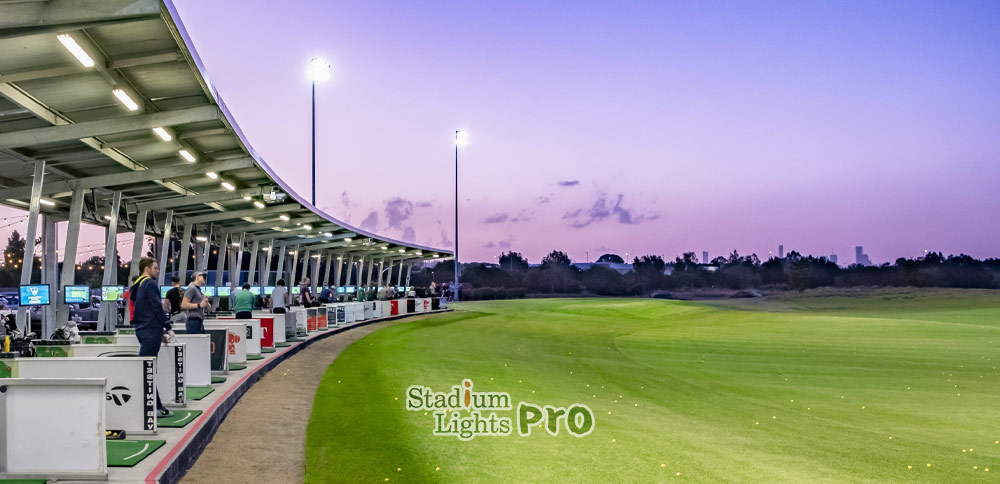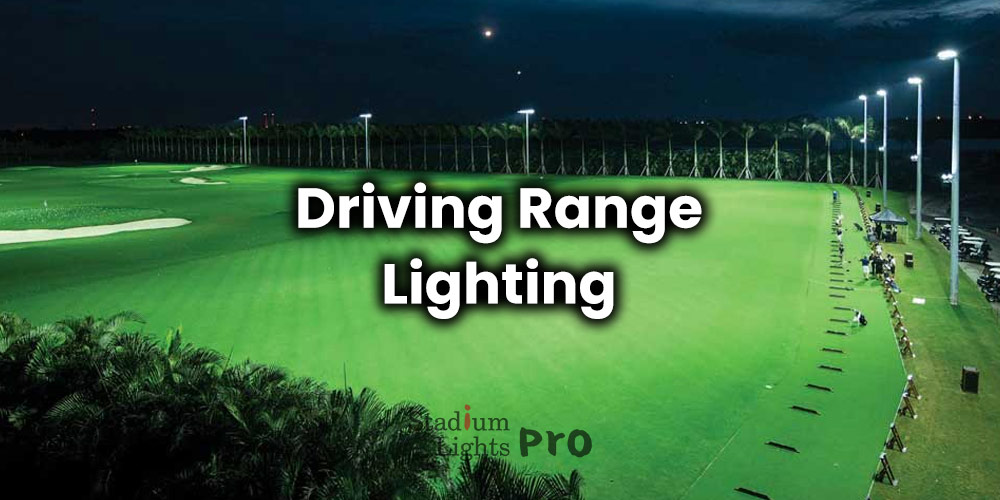A driving range is a facility at which golfers can practice their swing and hit balls using various clubs. It typically consists of a large open area with hitting stalls or mats, and a number of targets or greens at varying distances. Some driving ranges also have sand traps and other hazards to simulate real golf course conditions.
The purpose of a driving range is to provide golfers with a place to practice their swing and improve their golf game. It is also a place where beginners can learn the basics of the sport and get comfortable with the various clubs and techniques. Many driving ranges also offer lessons and clinics with trained instructors to help golfers of all skill levels improve their game.
Table of Contents
ToggleImportance of proper lighting for driving ranges
Visibility

Good lighting is essential for golfers to be able to see their shots and gauge the distance and direction of their shots accurately. It also allows golfers to see the targets and greens clearly, which is essential for practicing their aim and accuracy.
Safety
Adequate lighting helps them navigate the facility and avoid hazards, and also makes it easier for them to find their golf balls and clubs.
Comfort
Good lighting can make the experience of practicing on the driving range more enjoyable for golfers. It can reduce eye strain and fatigue, and also make the facility feel more welcoming and inviting.
Attractiveness
Proper lighting can also make a driving range more attractive to potential customers. A well-lit facility can create a more professional and inviting atmosphere, which can encourage golfers to come back and practice more often.
Types of lighting systems for driving ranges
Natural lighting
 Natural lighting refers to the light that comes from the sun. It is a common type of lighting used in driving ranges, particularly during the daytime.
Natural lighting refers to the light that comes from the sun. It is a common type of lighting used in driving ranges, particularly during the daytime.
Advantages of natural lighting for driving ranges include:
- It is free and renewable
- It provides a natural, warm light that can be more pleasant for golfers
- It can help reduce the need for artificial lighting, which can save energy and reduce costs
Yet, natural lighting also has some limitations:
- It is not always consistent or reliable, as it can be affected by weather conditions and the time of day
- It may not provide sufficient light during the early morning or late evening hours, when many golfers prefer to practice
- It can create shadows and glare that can make it difficult for golfers to see their shots accurately
Artificial lighting
Artificial lighting is commonly used in driving ranges to provide additional light or to supplement natural lighting.
Merits of artificial lighting:
- It can provide consistent and reliable light, regardless of weather or time of day
- It can be customized and controlled to provide the desired level of brightness and intensity
- It can be used to illuminate specific areas or targets on the range, which can be helpful for golfers practicing specific shots
However, artificial lighting has some drawbacks:
- It can be more expensive to install and operate than natural lighting
- It may produce a less natural or warm light than natural lighting
- It can generate heat and use energy, which can have an environmental impact
LED lighting
LED (light-emitting diode) lighting is a type of artificial lighting that uses semiconductor technology to produce light. It is becoming increasingly popular in driving ranges due to its energy efficiency, long lifespan, and durability.
Strengths of LED lighting for driving ranges:
- It is highly energy efficient, using up to 75% less energy than traditional incandescent lighting
- It has a long lifespan, lasting up to 100,000 hours or more
- It produces little heat and is resistant to damage from vibration or impacts
- It is available in a wide range of colors and brightness levels, allowing for customization
- It is generally more affordable in the long term due to its low energy consumption and long lifespan
LED lighting may also have some disadvantages:
- It may have a higher upfront cost than other types of lighting
- It may not be as bright as some other types of lighting, depending on the specific product and application
- It may produce a slightly bluish light that some people find less appealing than other colors of light
Factors to consider when choosing lighting for a driving range
Brightness and intensity of the light

Brightness refers to the amount of light that is emitted from a light source. It is typically measured in lumens (lm). A higher lumen rating indicates a brighter light, while a lower lumen rating indicates a dimmer light.
Intensity refers to the concentration of light in a specific area. It is typically measured in candelas (cd). A higher candela rating indicates a more intense light, while a lower candela rating indicates a less intense light.
When choosing lighting for a driving range, we need to consider the desired level of brightness and intensity based on the specific needs and goals of the facility. For example:
- If the driving range is used primarily during the daytime, lower brightness and intensity may be sufficient to supplement natural lighting and create a pleasant atmosphere.
- If the driving range is used primarily during the evening or in low-light conditions, higher brightness and intensity may be necessary to provide sufficient light for golfers to see and practice their shots accurately.
- If the venue has specific targets or greens that golfers are practicing towards, higher intensity lighting may be necessary to illuminate those areas and help golfers gauge their shots more accurately.
Energy efficiency
Golf facilities can consume a significant amount of energy, especially when lighting is involved. Choosing energy-efficient lighting can help reduce energy costs and minimize the facility’s environmental impact.
There are several ways to measure the energy efficiency of lighting:
Lumens per watt (lpw)
This is a measure of how much light is produced per unit of energy consumed. A higher lpw rating indicates a more efficient light source.
Energy Star
This is a program run by the US Environmental Protection Agency (EPA) that certifies products, including lighting, that meet certain energy efficiency standards. Products that are Energy Star certified are typically more energy efficient than non-certified products.
LED lighting
LED lighting is generally more energy efficient than other types of lighting, such as incandescent or fluorescent lighting. This is due to its high lpw rating and low energy consumption.
Cost
The total cost of lighting a driving range will depend on a variety of factors, including the size of the facility, the type of lighting chosen, and the installation and maintenance costs.
Upfront cost
This refers to the initial cost of purchasing and installing the lighting system. It may include the cost of the light fixtures, wiring, and labor.
Energy cost
This refers to the ongoing cost of operating the lighting system. It will depend on the energy efficiency of the lighting and the amount of energy consumed.
Maintenance cost
This refers to the cost of maintaining the lighting system over time. It may include the cost of replacing bulbs or other components, as well as any repairs or maintenance needed.
Durability and maintenance
Golf facilities can be challenging environments for lighting, as they may be exposed to weather, vibration, and impacts from golf balls. Choosing durable and low-maintenance lighting can help reduce the need for repairs and maintenance over time, which can save time and money.
Material and construction
Lighting fixtures that are made from durable materials, such as aluminum or stainless steel, and have sturdy construction may be more resistant to damage and wear over time.
Water and weather resistance
Lighting fixtures that are designed to withstand exposure to rain, wind, and other weather conditions may be more durable and require less maintenance in outdoor environments like driving ranges.
Impact resistance
Lighting fixtures that are resistant to impacts from golf balls or other objects may be less prone to damage and require less maintenance.
Lifespan
Lighting fixtures with a longer lifespan may require less maintenance and replacement over time, which can save money and reduce downtime.
Environmental impact
Golf facilities can consume a significant amount of energy, especially when lighting is involved. Choosing lighting options that have a lower environmental impact can help reduce the facility’s carbon footprint and contribute to a more sustainable operation.
Recyclability
Lighting options that are made from recyclable materials or can be easily recycled at the end of their lifespan may have a lower environmental impact than options that are not recyclable.
Eco-labeling programs
Programs like Energy Star and LEED (Leadership in Energy and Environmental Design) certify products, including lighting, that meet certain environmental performance standards. Choosing lighting options that are certified by these programs can help ensure that the facility is using more sustainable products.
Case studies or examples of successful driving range lighting projects

Golf Central BNE is a popular golf facility located in a suburban area. It has a large driving range with 20 hitting stalls and several greens at varying distances. The facility is open from dawn until dusk, but many golfers prefer to practice in the evening when it is cooler and less crowded.
In order to provide consistent and reliable lighting for its customers, Golf Central BNE decided to install an LED lighting system. The facility chose LED lighting due to its energy efficiency, long lifespan, and durability.
The LED lighting system was installed by a professional lighting company, and included energy-efficient LED light fixtures, wiring, and controls. The system was designed to provide sufficient brightness and intensity to illuminate the hitting stalls and greens, while also minimizing energy consumption and maintenance needs.
Since installing the LED lighting system, Golf Central BNE has seen a number of benefits. The facility has received positive feedback from customers who appreciate the consistent and reliable lighting, and has also seen an increase in evening business as a result. Additionally, the facility has experienced a reduction in energy costs due to the energy-efficient LED lighting, which has helped to offset the upfront cost of the installation. The LED lighting system has been a successful investment for Golf Central BNE, and has helped to create a more pleasant and inviting atmosphere for customers.
Conclusion
Proper lighting is essential for driving ranges in order to provide visibility, safety, comfort, and attractiveness for golfers. There are several types of lighting systems to consider, including natural lighting, artificial lighting, and LED lighting, each with its own advantages and limitations.
When choosing lighting for a driving range, we may consider factors such as brightness and intensity, energy efficiency, cost, durability and maintenance, and environmental impact. By carefully considering these factors, driving range operators can choose a lighting system that meets the needs of their facility and its customers, while also being cost-effective and sustainable.
If you are considering updating or improving the lighting at your driving range, we invite you to contact us for a complimentary lighting design consultation. Our team of experienced lighting professionals will be happy to discuss your specific needs and goals, and provide recommendations for a lighting system that will meet the unique requirements of your facility.
Whether you are looking for a more energy-efficient solution, or want to create a brighter and more inviting atmosphere for your customers, we can help you find the right lighting solution for your driving range.

